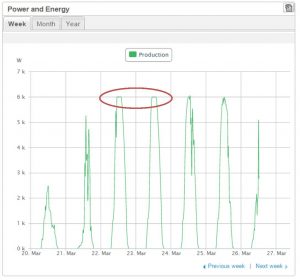The short answer is that “inverter clipping” means your solar inverter is limiting slightly the amount of electricity going from your solar energy system into your household for use, because it reached its maximum capacity.
Here’s a longer explanation.
For background you should know that, like solar panel ratings, inverter ratings are approximate. Many inverters can convert more DC power (from your panels) to AC (for use in your home or business) than their model numbers imply. For example, the maximum power output of the SolarEdge SE7600A is actually 8,350 watts, according to the manufacturer. So the inverter has no problem handling up to 8,350 watts of capacity at a time.
If the panels are operating at a capacity that exceeds the inverter’s capacity, “clipping” occurs. The inverter trims the output to the maximum it can handle and you lose a little production. This graph shows a customer’s production with clipping at the top of the curve.
 Clipping should not damage any component of your solar energy system. It does limit your production a smidge.
Clipping should not damage any component of your solar energy system. It does limit your production a smidge.
You may be wondering why New England Clean Energy or your solar installer didn’t install a bigger inverter so you wouldn’t experience any clipping. There’s a good reason for that.
Inverters are most efficient when running at or near full capacity. Going up an inverter size, for example installing an SE-10,000 inverter with a 7,500-watt system, would make the system less efficient. The lost production in that scenario would be more than the little bit of production lost from occasional clipping.
Put another way, the choice is lower efficiency 365 days a year, or very high efficiency year-round with occasional clipping. You get considerably more solar production in the second scenario.
In fact, sometimes it’s worth going slightly bigger with the system because even if that means a tad more clipping, the overall production gain is worth it. Bottom line: work with your installer to size the system for your needs.
Many of our systems never experience clipping. Some experience it maybe a few days a year, for a few hours at a time. If your system shows clipping, don’t worry as long as your overall production is on target.
If you liked this article, you might also enjoy:
- Why October is a Trick not Treat for Solar (Seasonal Production Variations)
- What’s in a Solar Production Estimate?
- STC vs. PTC: Why Solar Panel Testing Matters





No comments yet. You should be kind and add one!
The comments are closed.